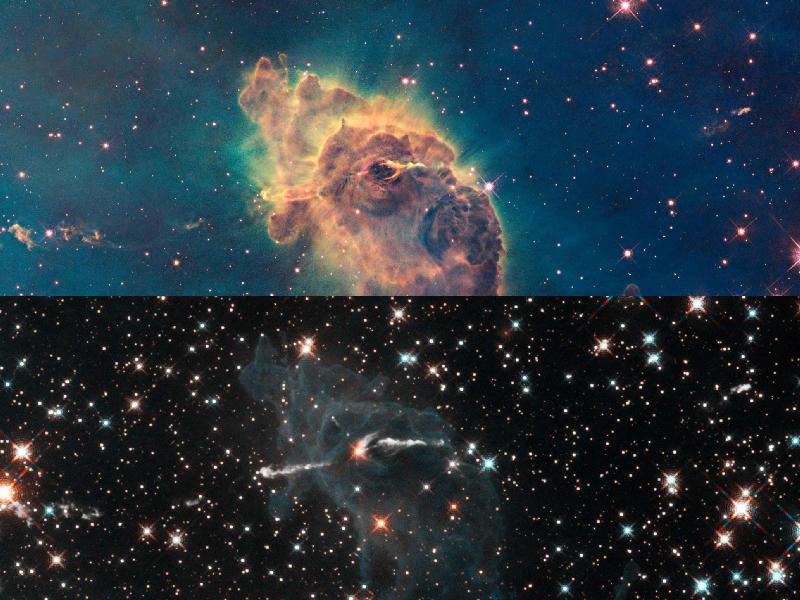The Carina Nebula is the chaotic place where the stars are born and burst into space, and this time Hubble's ability to photograph in infrared and visible light is illustrated

Another spectacular image taken by the renewed Hubble Space Telescope, from those presented this week at the press conference in Washington by a team Space Telescope Science Institute.
Two images of the vast column of gas and dust within which stars are born demonstrate how the Hubble Space Telescope's ability to simultaneously observe visible and infrared light has improved dramatically. This ability allows you to see a completely different perspective on the same objects.
The images provide one tangible example of the ability to photograph over a wider range of wavelengths in the hands of Planetary Camera #3 - the new camera installed on Hubble last May, which extends from ultraviolet light (as in the case of The Butterfly Nebula) and infrared light.
The pillar, composed of dust and gas, resides in a baby star known as the Carina Nebula, located about 7,500 light-years from us in the southern group Carina. The pair of images provides astronomers with a more comprehensive view of the column and its contents when important details not visible in visible light are revealed in near infrared light.
The top image, taken in visible light, shows the head of the pillar, which is 3 light years long, glowing in the light of hot, massive stars above it, outside the image. Scorching radiation and high-speed winds (streams of ionized particles) from these stars shape the column and cause new stars to form within it. Streams of gas and dust are seen flowing out of the top of the structure.
Deep within the tangled structure are stars. They cannot be seen in the image because they are hidden behind a wall of gas and dust. However, although the stars themselves are not visible, one of them provides evidence of its presence. You can see the small puff of material that can be seen migrating on the side that is full and to the right of the dark slot in the center of the page. The material is part of a jet created by a young star. Far away, on the full side, the jet was seen as an association of small, faint clouds. A number of small clouds are visible at a similar distance to the right side of the jet. The astronomers estimate that the jet moves at a speed of about 1.36 million km/h. The full length of the jet is over 15 light years.
In the lower image, taken in infrared light, the compressed column and the greenish gas surrounding it are more prominent, although only the outer contours of the column remain intact. By penetrating the wall of gas and dust, the infrared vision capability of Planetary Camera #3 reveals a young star that is likely the source of the jet. Part of the jet near the star is more prominent from this vantage point. These lines can be seen because infrared light, unlike visible light, can pass through dust.
Another young star within the column is also about to hatch. Three examples of this are the bright star almost directly below the star producing the jet, another fainter star to the right, and another pair of stars above the column. Winds and radiation from some of the stars blow out gas from their surroundings, thus excavating large spaces that look like gaping dark holes.
Around the star hatchery there is a treasure trove of stars, most of which are not visible in visible light because they are hidden by compressed gas clouds. Many of them are background stars visible only on such occasions.
Planetary Camera #3 photographed the Carina Nebula from July 24 to 30, 2009.

One response
Stunning!